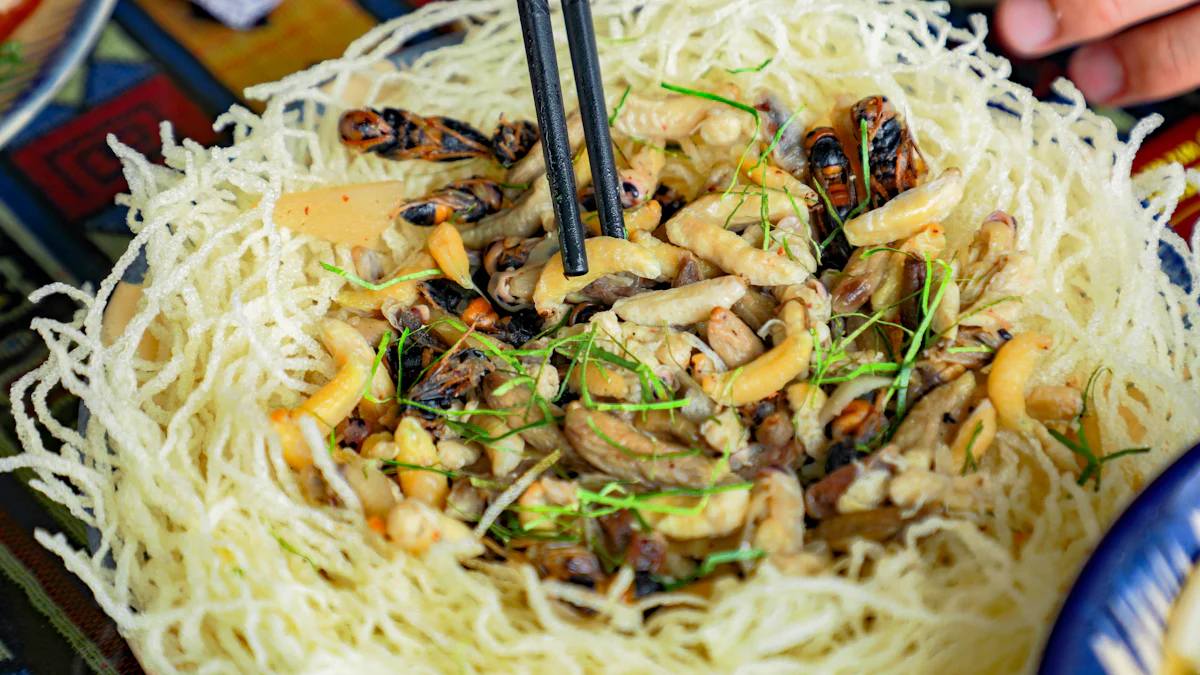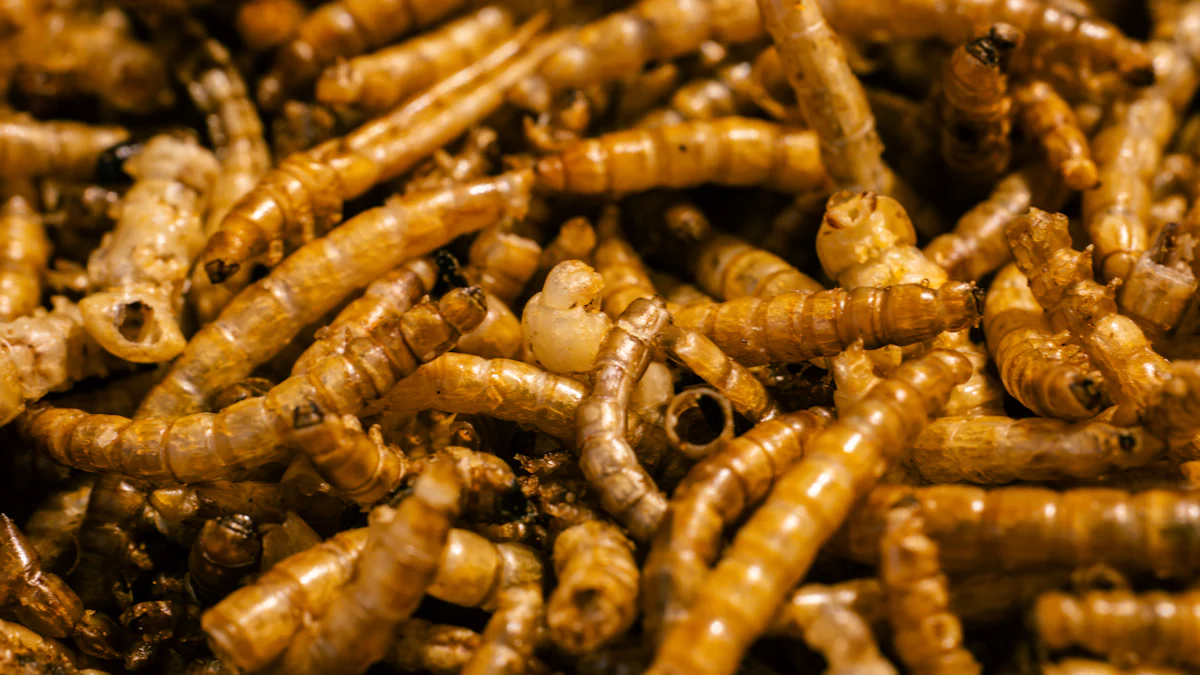
Mealworms are more than just pet food—they’re a nutritious delicacy fit for human consumption. Packed with high-quality protein, they rival traditional meat sources while offering healthy fats like polyunsaturated fatty acids. They’re also rich in essential vitamins and minerals, including B12, zinc, and magnesium.
Beyond nutrition, mealworms are a sustainable food option. They require less land, water, and feed compared to livestock, making them an eco-friendly choice. Plus, they thrive on organic waste, reducing food waste and promoting a circular economy. Whether fried, roasted, or even powdered, mealworms can spice up any diet with their versatility and unique flavor.
So, can humans eat mealworms? Absolutely! With proper preparation, they’re safe, delicious, and a step toward a more sustainable future.
Key Takeaways
- Mealworms are healthy and full of protein, vitamins, and minerals. They can be a good replacement for regular meats.
- Pick mealworms meant for eating to stay safe. Do not use wild ones to avoid bad germs or dirt.
- Clean mealworms well before cooking. Feed them clean food for 1-2 days. Freeze them for 1-2 days to kill any bugs inside.
- You can cook mealworms by roasting or frying them. Add them to salads, soups, or baked foods for more protein.
- Mealworms are good for the planet. They need less space and water than farm animals, so they are a smart food choice.
Why Can Humans Eat Mealworms?
Mealworms are packed with nutrients, especially protein. This nutritious delicacy is fit for both pet and human consumption. You can enjoy it in various forms, including fried, roasted, and even live! What better way to spice up your diet than to include mealworms?
Nutritional Benefits
High in protein, vitamins, and minerals
Mealworms are a powerhouse of nutrition. They contain 49-56 grams of protein per 100 grams, making them an excellent source for muscle repair and immune support. They’re also rich in essential fatty acids, which promote brain health, and dietary fiber, which aids digestion. On top of that, mealworms are loaded with vitamins like B12, B5, and B2, which boost metabolism and strengthen the nervous system. Minerals such as iron, zinc, and magnesium further enhance oxygen transport, bone health, and immune defense.
Here’s a quick breakdown of their nutritional highlights:
- Vitamins: B12, B5, B2, and E.
- Minerals: Iron, zinc, magnesium, potassium, and copper.
- Other benefits: High protein content and essential fatty acids.
A healthy alternative to traditional meat
Mealworms offer a lean, nutrient-dense alternative to traditional meats like beef or pork. They provide similar protein levels but with fewer calories and less saturated fat. Plus, they’re free from antibiotics and hormones often found in conventional livestock. For those looking to reduce their meat consumption without sacrificing nutrition, mealworms are a fantastic option.
Environmental Sustainability
Low environmental impact
Farming mealworms is incredibly eco-friendly. Compared to traditional livestock, mealworms produce significantly fewer greenhouse gases and require much less water. For instance, producing one kilogram of beef can use up to 22,000 liters of water, while mealworms need only a fraction of that. They also take up far less land, helping preserve natural habitats.
| Aspect | Mealworms | Traditional Livestock |
|---|---|---|
| Greenhouse Gas Emissions | Significantly lower | Higher |
| Land Usage | Much less | More |
| Water Usage | Requires a fraction | Up to 22,000 liters/kg |
| Feed Conversion Efficiency | Similar to poultry | Lower |
Efficient resource use
Mealworms are champions of resource efficiency. They require less feed than cattle, pigs, or chickens to produce the same amount of protein. Their farming also generates less ammonia, reducing environmental pollution. These qualities make mealworms a sustainable choice for feeding a growing global population.
Culinary Versatility
Suitable for snacks, meals, and desserts
Mealworms can fit into almost any dish. They’re perfect for snacks like roasted mealworms or can be added to meals such as stir-fries and salads. Some creative recipes even use them in desserts like cookies or brownies. Popular dishes include Mealworm Lentil Salad and Spicy Mealworm Mac N’ Cheese.
Available in various forms like whole or powdered
Mealworms come in different forms to suit your cooking needs. Whole mealworms are often sold as crunchy snacks, while mealworm powder is a versatile ingredient for baking or seasoning. The powder enhances flavor and boosts protein content in foods like bread, cakes, and even pasta.
So, can humans eat mealworms? Absolutely! They’re nutritious, eco-friendly, and incredibly versatile in the kitchen.
How to Safely Prepare Mealworms
Selecting Mealworms
Choose food-grade mealworms
When preparing mealworms for human consumption, always start with food-grade options. These mealworms are specifically raised for eating and meet safety standards. They’re free from harmful contaminants and are bred in controlled environments. Purchasing from reputable suppliers ensures the mealworms are clean and safe to eat.
Avoid wild-caught mealworms
Wild-caught mealworms might seem like an adventurous choice, but they come with risks. They can harbor harmful bacteria like Salmonella or E. coli, accumulate heavy metals, or carry parasites. Brightly colored or fuzzy insects should be avoided entirely. Cooking wild mealworms can reduce some risks, but it’s better to stick with farmed, food-grade options to ensure safety.
Cleaning and Purging
Remove debris and impurities
Before cooking, mealworms need thorough cleaning. Start by sorting through them to remove any damaged or dead ones. Rinse them under cold water to wash away dirt and debris. This step ensures that only the healthiest mealworms make it to your plate.
Feed a clean diet for 24-48 hours
Mealworms should be purged before consumption. This process involves feeding them a clean diet for 1-2 days to clear their digestive systems. Avoid citrus or overly watery foods, as these can harm the mealworms. Instead, provide grains like oats or bran, along with small amounts of vegetables. A varied diet improves their nutritional value, making them healthier for consumption.
Freezing and Storing
Freeze for at least 24 hours to kill parasites
Freezing mealworms is a crucial step. It kills parasites and humanely dispatches the insects. Place them in a freezer set between -10° to -20°C (14° to -4°F) for 24-48 hours. This ensures they’re safe to eat and ready for cooking.
Store in airtight containers
Proper storage keeps mealworms fresh and safe. Use airtight containers to prevent moisture and contamination. For long-term storage, dried mealworms or mealworm powder can last months when kept in a cool, dark place. Regularly check for spoilage to maintain quality.
Cooking Methods for Mealworms

Roasting
Steps to roast mealworms
Roasting mealworms is one of the easiest ways to enjoy their nutty flavor and crunchy texture. Follow these simple steps:
- Preheat your oven to 350°F (175°C).
- Line a baking sheet with parchment paper to prevent sticking.
- If using fresh mealworms, rinse and pat them dry with a paper towel.
- Toss the mealworms with a small amount of oil and your favorite seasonings.
- Spread them out in a single layer on the baking sheet.
- Roast for 10–15 minutes, stirring halfway through to ensure even cooking.
- Let them cool before serving or adding to recipes.
Tip: Roasted mealworms make a great snack or topping for salads and soups.
Tips for seasoning
Seasoning can elevate the flavor of roasted mealworms. Here are some popular options:
| Seasoning Option | Flavor Profile |
|---|---|
| Salt | Classic and simple |
| Garlic Powder | Savory and aromatic |
| Paprika | Smoky with a hint of sweetness |
| Chili Powder | Spicy and bold |
| Lemon Juice | Fresh and tangy |
| Butter | Rich and creamy |
Experiment with combinations like garlic powder and paprika or butter and parsley for a unique twist.
Frying
How to fry mealworms
Frying mealworms creates a crispy, golden treat. Here’s how to do it:
- Start by boiling frozen mealworms for 3 minutes to ensure they’re clean and safe.
- Heat vegetable oil in a wok or skillet over high heat.
- Add the mealworms and fry for 2–3 minutes until they turn golden brown.
- Remove them from the oil and place them on a paper towel to drain excess oil.
Tip: Fried mealworms pair well with dipping sauces like soy sauce or spicy mayo.
Suggested spices and coatings
For extra flavor, coat the mealworms before frying. Try these ideas:
- Toss them in a mix of flour, salt, and pepper for a light, crispy coating.
- Add chili powder or paprika for a spicy kick.
- Sprinkle with Parmesan cheese after frying for a savory finish.
Adding to Recipes
Incorporating into soups, salads, and stir-fries
Mealworms can add crunch and protein to many dishes. Here are some creative ways to use them:
- Toast them lightly in a pan with olive oil, salt, and pepper, then sprinkle over salads.
- Mix them into roasted vegetables for added texture.
- Stir-fry them with onions, bell peppers, and mushrooms, then toss with soy sauce for a quick meal.
Pro Tip: Blanch mealworms before adding them to stir-fries to enhance their flavor and texture.
Using as a protein substitute in baked goods
Mealworm powder is a versatile ingredient for baking. It boosts the protein content of bread, cakes, and muffins. Whole mealworms can also be blended into burger patties or sausages for a unique twist.
Fun Idea: Add mealworm powder to pancake batter for a nutritious breakfast treat.
Where to Source Mealworms
Online Retailers
Reputable websites for food-grade mealworms
Finding food-grade mealworms online is easy with reputable retailers. Sunshine State Worms is a trusted option. They specialize in mealworm products like small mealworms and superworms, which are raised in controlled environments. These mealworms meet safety standards, making them suitable for human consumption. Many online platforms also offer mealworm powder and snacks, giving buyers plenty of choices.
Tips for verifying quality
When shopping online, always verify the quality of the mealworms. Look for sellers that provide detailed product descriptions, including how the mealworms are raised and processed. Check customer reviews to see if others had positive experiences. If possible, choose vendors that offer certifications or lab testing results to ensure the mealworms are free from contaminants.
Specialty Stores
Finding edible insects locally
Local specialty stores are another great place to find mealworms. Health food stores often stock edible insects, including mealworm-based protein mixes and snacks. Specialty food stores may carry mealworm powder or even fresh mealworms for cooking. Bird feeding stores sometimes sell mealworms, though these may not always be food-grade. Always confirm their suitability for human consumption before purchasing.
How to inquire about mealworms
When visiting a store, asking the right questions ensures you get safe and high-quality mealworms. Here’s a handy table of concerns to address:
| Concern | Details |
|---|---|
| Bacterial Contamination | Ask if the mealworms are tested for pathogens like Salmonella or E. coli. |
| Allergic Reactions | Check if they warn about potential reactions for those with shellfish allergies. |
| Chemical Contaminants | Inquire about testing for heavy metals or toxins in the mealworms. |
| Cooking Temperature | Confirm if they recommend cooking mealworms to at least 158°F (70°C). |
| Cleaning | Ask if the mealworms are pre-cleaned or require additional preparation. |
| Freezing | Verify if freezing is necessary to kill parasites before cooking. |
| Drying | Check if dried mealworms are available for longer shelf life. |
DIY Farming
Basics of home mealworm farming
Starting a mealworm farm at home is simple and cost-effective. Follow these steps to get started:
- Use a plastic storage container at least 5 inches deep. A wider container works best.
- Add 2-4 inches of wheat bran or oatmeal as bedding.
- Drill ventilation holes in the lid or replace the center with mesh.
- Introduce mealworms to the container.
- Place slices of potato or carrot for moisture and food.
- Keep the container in a dark, warm spot for optimal growth.
With these steps, anyone can create a sustainable source of mealworms right at home.
Ensuring cleanliness and safety
Maintaining a clean and safe mealworm farm is essential. Here are some tips to keep your farm healthy:
- Keep the habitat at 80°F with 65-70% humidity to prevent grain mites.
- If mites appear, lower humidity below 50% and clean the colony thoroughly.
- Separate mealworms, pupae, and beetles regularly to avoid overcrowding.
- Wash containers and surfaces with hot soapy water and vacuum nearby areas.
- Remove moisture-raising items like potatoes after 24 hours to control humidity.
By following these practices, home farmers can ensure their mealworms are safe and ready for consumption.
Preparing mealworms for consumption is simple and safe when following these steps:
- Select healthy, food-grade mealworms.
- Purge them for 1-2 days to cleanse their digestive systems.
- Freeze for 24-48 hours to eliminate parasites.
- Boil for 3 minutes to ensure cleanliness before cooking.
Mealworms are a powerhouse of nutrition. They provide high-quality protein, healthy fats, and essential vitamins like B12 and zinc. Environmentally, they require up to 90% less land than beef and produce fewer greenhouse gases, making them a sustainable choice.
Tip: Start small by adding roasted mealworms to salads or using mealworm powder in baked goods. It’s an easy way to explore this eco-friendly protein source! 🌱
FAQ
Can mealworms cause allergies?
Yes, mealworms can trigger allergies in some people, especially those allergic to shellfish. They contain similar proteins that may cause reactions. Always consult a doctor before trying mealworms if you have food allergies.
Tip: Start with a small portion to test for any adverse reactions.
How do mealworms taste?
Mealworms have a mild, nutty flavor with a hint of earthiness. Their taste depends on how they’re cooked. Roasting enhances their nuttiness, while frying adds a crispy texture. They easily absorb seasonings, making them versatile for various dishes.
Fun Fact: Some people compare their taste to sunflower seeds or toasted nuts!
Are mealworms safe for kids to eat?
Yes, mealworms are safe for kids when properly prepared. They’re a great source of protein and nutrients. However, ensure they’re food-grade and cooked thoroughly to avoid any risks. Always supervise children when trying new foods.
Note: Check for allergies before introducing mealworms to a child’s diet.
Can mealworms replace meat in meals?
Absolutely! Mealworms are a high-protein alternative to meat. They’re lean, nutrient-dense, and eco-friendly. Use them in stir-fries, soups, or even as a protein boost in baked goods. Mealworm powder works well in recipes like burgers or pasta.
Pro Tip: Combine mealworm powder with spices for a flavorful meat substitute.
How long can mealworms be stored?
Dried mealworms can last several months in airtight containers stored in a cool, dark place. Fresh mealworms should be frozen for long-term storage. Always check for spoilage before use.
Reminder: Proper storage ensures mealworms stay fresh and safe to eat.


